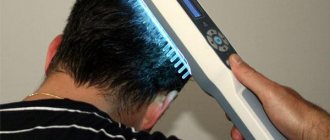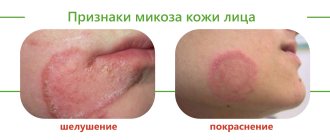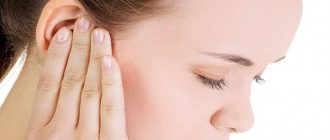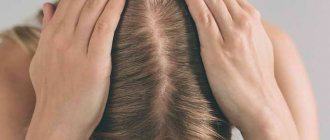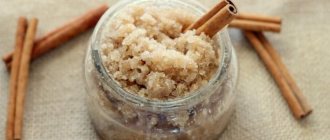Trichology (from the Greek “trichos” - hair, “logos” - science) is the science of hair and scalp, which studies the structure and physiology of hair, develops theoretical and practical methods for treating hair and scalp.
In the West, trichology as a separate scientific direction was formed in the middle of the 20th century. Since then, there has been a qualitative breakthrough in its development: from small scattered schools and individual doctors to large associations, centers and institutes for the study of hair. Trichology appeared in Russia later, in the early 1990s. And like any science, with the accumulation of scientific data, it has now acquired an integrated approach to the treatment of trichological diseases.
Reasons for visiting a trichologist
- increased hair loss,
- loss of hair volume,
- dandruff and itching of the scalp.
Scalp diseases: names and causes
Common skin diseases are considered to be:
- diseases of a dermatological nature (including seborrhea, eczema and hyperkeratosis);
- autoimmune diseases of the scalp (including psoriasis and scleroderma);
- infectious (formation of pustules, appearance of lice, etc.);
- fungal rashes.
Whatever the cause of the disease, it must be eliminated in time. It is important to start treatment as early as possible, because wasted time can have serious consequences.
Wounds
If wounds appear on the head, there are many reasons - from excessively hard bristles of the comb to recurrent psoriasis. Such affected areas cause discomfort, itching and itching. In advanced cases, they become wet, bleed and increase in size.
Among the provoking factors:
- thermal burns;
- excessive dryness of the head;
- avitaminosis;
- frequent stress;
- diseases of the central nervous system;
- result of chemotherapy.
Sores after paint
After chemical hair dyeing, red spots, dandruff, itching and burning may appear on the skin. These are pronounced symptoms of burns in women and men against the background of preliminary coloring of the strands.
If such symptoms appear, do not panic ahead of time. You can use Panthenol or Panthenol D spray. No less effective are rinsing your hair with decoctions of chamomile or St. John's wort.
Sores from ingrown hairs
If your shaving technique is not correct, the problem of ingrown hair may arise. Externally it is a small pimple in an unusual place, internally it is a sluggish inflammatory process. Such pimples cause discomfort, pain and itching, and redness of the skin is observed.
The patient feels an incomprehensible growth that is painful on palpation. Ingrown hair cannot be eliminated conservatively; it must be removed. Effective methods include mechanical removal with tweezers and chemical depilation.
Nerve wounds
All diseases from nerves, the appearance of wounds on the head are no exception. Potential diagnoses include urticaria, nervous allergies and scabies, psoriasis, and eczema. All diseases are accompanied by an aesthetic defect, and the latter by self-doubt and even suicidal tendencies.
Scabbers
This is an infectious disease that is transmitted by contact. The main pathogen is scabies, which lays eggs and intensively affects the skin with its saliva. Scabs on the head are profuse rashes with a weeping component. Not only the head, but also the area behind the ears and other parts of the body can become crusty.
If scabs have formed, you cannot hesitate. The patient experiences an acute sensation of itching and can injure the skin or accidentally become infected. In the latter case, the body becomes covered with small ulcers, and the patient does not know peace either day or night. During treatment, the patient is isolated and a course of ointments is recommended.
Causes and signs of dermatological diseases
The appearance of dermatological diseases of the scalp in a patient occurs when the sebaceous glands work abnormally. For example, the well-known disease seborrhea occurs in people who constantly live in a stressful state, which leads to a malfunction of the gastrointestinal tract, and constant snacking on fast food and sweets only worsens the clinical picture.
Seborrhea can occur as a result of hormonal imbalance. Moreover, it is observed equally in both the male and female populations in equal numbers. Rare causes of the disease include hereditary predisposition. It's rare, but it happens. At the moment, doctors cannot answer with certainty which link in the genetic code is responsible for the transmission of seborrhea in the family.
Self-medication is not recommended - it can only cause harm. To establish an accurate diagnosis, you need to contact a specialist in skin diseases, who will refer you to an andrologist/gynecologist to identify pathological processes in the reproductive system. Based on the results obtained, adjustments are made to the diet, physiotherapy is prescribed, and, if necessary, a diet and a course of medications.
Irritation
If irritation and itching appear, the person experiences discomfort, begins to scratch his head and becomes very nervous. Such scratching is dangerous because a pathogenic infection can penetrate into the skin and nails. As a result, sores appear that bleed and hurt, causing an inferiority complex and mental suffering.
Causes of skin irritation include:
- dandruff;
- allergic reaction;
- seborrhea;
- parasite activity;
- dry skin;
- fungi;
- inflammatory processes;
- frequent hair washing.
There are cases when irritation is caused by an excessive emotional state or stress. In this case, the unpleasant symptom disappears when the patient stops being nervous, calms the nervous system and relaxes.
Fungal diseases: causes and symptomatic picture
Fungal diseases of the scalp partially or completely affect the scalp. They are transmitted through tactile contact and the use of shared personal hygiene products (towel, comb), clothing and hats.
A common fungal disease is ringworm. The superficial form most often affects children of preschool and school age due to curiosity and frequent contacts with animals - cattle and rodents. According to statistics, lichen more often affects residents of villages and villages.
In most cases, it is characterized by the appearance of small spots, pinkish with a pale edge. Despite its frequent distribution among children, trichophytosis can appear in men and women of different age categories.
Treatment of fungal diseases of the scalp can take an indefinite period of time. If the disease is chronic, treatment of the scalp disease in this case does not guarantee complete relief.
Weeping sores
Such wounds appear in adults and children and are considered common. Alternatively, it is a small rash, red lumps that itch and itch. If treatment is not started in a timely manner, a secondary infection may develop and sores may fester.
Water spots on the head are formed for the following reasons:
- immunodeficiency states;
- diseases of internal organs and systems;
- disturbances in the digestive tract.
When such unpleasant symptoms appear, the doctor prescribes medicinal ointments for a course of up to 2-3 weeks. To accelerate the therapeutic effect, oral administration of medications according to indications and a course of pharmaceutical vitamins are necessary.
Autoimmune diseases: causes and methods of treatment
For healthy people, patients with psoriasis or scleroderma do not pose any threat; these diseases are associated with a deficiency of essential vitamins and minerals in the body. The patient must be protected from situations that cause depression, anxiety and stress, after which the doctor prescribes oral drug treatment, namely:
- take a course of medications with a high content of vitamins, amino acids and minerals necessary for the recovery of the body;
- sedatives (if the patient is unable to get rid of stress on his own).
Mixed seborrhea
Mixed seborrhea has characteristics of dry and oily varieties. In particular, patients note that the skin on the face in the middle part is oily, and on the cheeks it is dry. Especially a lot of fat is released in the areas of the crown, chin, forehead, and nose. In other places the fat content is moderate or insufficient.
Doctors also note that a person may be bothered by dry dandruff and oily skin on the face.
Symptoms of mixed seborrhea:
- inflammatory process on the cheeks, scalp, chin, forehead, chest, nose;
- in the area of inflammation, the skin becomes rough;
- redness, itching;
- increased secretion of sebum on the forehead, but decreased secretion in other areas of the face;
- peeling in the area of increased activity of fat-secreting glands, yellowish or gray scales;
- peeling of dry areas of skin.
All the factors listed above as causes of other types of the disease can provoke mixed seborrhea. Most often the problem is associated with hormonal changes or disruptions. Heredity plays an important role. Stress and anxiety can also contribute to the growth of fungi.
Message sent!
Drug therapy for scalp psoriasis?
Medicines are selected according to the patient’s condition and the presence of certain symptoms of the disease. In the initial stage of psoriasis on the scalp, the following external remedies are used:
- when weeping, solutions and creams are prescribed that eliminate these symptoms and prevent bacterial and fungal infections; Picladol, Psorilom, Zinocap creams are suitable; Belosalik is prescribed from solutions; apply the medicine to the affected skin areas every day;
- if the skin is dry, then it is treated with ointments; ointment with salicylic acid - has a softening effect; ointments with tar have the same effect; Ointments with zinc and Daivonex ointment (an analogue of vitamin D3 + glucocorticoid betamethasone - help quickly eliminate the symptoms of psoriasis);
- ointments and creams with corticosteroid hormones are prescribed for the treatment of common forms of psoriasis on the scalp;
- Shampoos are widely used; Thus, tar shampoos (Psorilom, Friederm Tar, etc.) relieve inflammation and soften crusts; shampoo with zinc has an antiseptic and softening effect, relieves inflammation; shampoos are used for a long time.
First aid for blisters on the head in the hair
To reduce discomfort, you need not touch the blisters, do not peel off the crusts from them and do not squeeze out the contents of the inflamed follicles, even if there is itching and discomfort.
You need to switch to children's hypoallergenic shampoo, wash your hair with gentle, not sudden movements, so as not to damage the scalp.
In order to reduce discomfort, you need to wash your hair with menthol shampoo or make a mask from a strong decoction of mint with a few drops of tea tree oil and menthol, if the scalp does not dry out.
It will reduce discomfort and restore your comfort. To prepare it, you will need:
- 50 strong and cold decoction of mint;
- 10 drops each of tea tree and menthol oils;
- 1 egg white.
Mix all ingredients until smooth, then apply to scalp. The mask should be worn for 30 minutes and washed off with cool water.
Using a special clay hair mask, which you can buy at a pharmacy or store, also helps. Although it does not completely eliminate fungus or inflammation, it significantly reduces discomfort.
Attention! During treatment, your doctor may prescribe you antifungal gels, ointments, and shampoos. During treatment, you should use only these products.
If you decide to make masks or rinse your scalp with herbal decoctions, apply them only to dry and clean scalp.
How to Care for Blisters
First of all, comb your hair gently so as not to injure your scalp. It is better not to use combs with sharp teeth. Use special antifungal shampoos and gels if necessary.
At this time, try not to make tight ponytails, knots or complex hairstyles, and do not use hairpins or hairpins.
Blisters need to be lubricated with special ointments and gels prescribed by the doctor.
It is also worth making regular masks with tea tree, hair clay and menthol - they reduce inflammation. And, of course, keep your hair clean and wash your hair regularly, maybe more often than before.
Is it worth scratching blisters or not and what can it lead to if you scratch them?
No, you should never scratch them. You can introduce an infection into the wound and inflammation will spread throughout the scalp.
How to treat allergic dermatitis, watch this video:
Carrying out diagnostics
If a sore is suspected, a comprehensive diagnosis is carried out based on:
- collecting medical history data;
- studying patient complaints;
- carrying out dermatological and laboratory tests.
In the latter case, dermatoscopy and dermatography are non-invasive diagnostic methods. If allergic reactions are suspected, a series of tests are performed to identify the potential allergen. Urine and blood tests are also prescribed to identify the inflammatory process in the body.
What is seborrheic dermatitis?
The best environment for seborrhea is sebum, or rather the presence in its composition of certain fatty acids, where a number of microbes prefer to be active. Seborrhea can develop due to comedones, which appear when sebum is not completely and not promptly removed from the surface of the skin, resulting in clogged pores.
There are two types of seborrhea:
- oily (more often occurs in adolescents during puberty, as well as with gastrointestinal disorders or chronic infections and even caries): this type is characterized by acne and oily hair;
- dry skin is characterized by a decrease in sebum secretion, which causes complications such as comedones, acne and dandruff.
Sometimes mixed seborrheic dermatitis is diagnosed, which combines the signs of both forms of the disease.
Seborrheic dermatitis in infants and children of other ages
In infants, the disease most often manifests itself in the first weeks of life and is characterized by round, scaly spots of varying sizes. Treatment at this age is usually not required, since the dermatitis goes away on its own and leaves no traces.
Seborrheic dermatitis can appear in children aged 2–4 years (most often diagnosed at this age), but this does not mean that other age groups are not at risk, since the main factors that provoke the occurrence and spread of the disease are weak immunity , chronic or recent infections and genetic predisposition.
If in newborn children seborrheic dermatitis often goes away without treatment, then in an older child the disease cannot be left without control and a visit to a pediatric dermatologist. Treatment under the supervision of a doctor is necessary to get rid of the disease as quickly as possible and prevent the occurrence of exacerbations and undesirable consequences.



